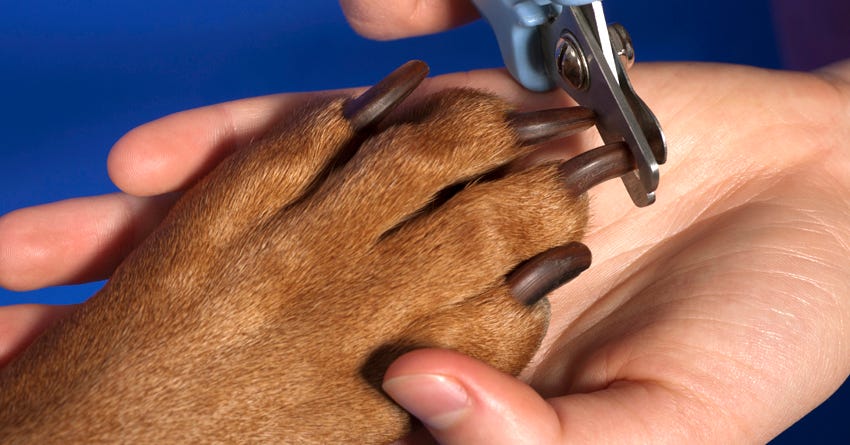Don't Let Your Dog's Toenails Scare You

I recently asked a group of dog owners which dog care chore was their least favorite.
Most of them said trimming toenails was the chore they liked the least and several added that this chore scared them. Not one dog owner said this chore was easy, and a few mentioned they disliked the chore enough to pay the veterinarian or groomer to trim their dog's nails. It's too bad this necessary chore is such a problem; however, it doesn't have to be that way.Get to Know Your Dog's Nails
Your dog's nails are made of keratin just as ours are. Our nails are flat with a slight curve and located on the top end of our fingers and toes but your dog's nails are oval and grow out of the end of each toe. The dog's nails are different from ours, too, in that they come to a point. If the nails don't wear off the point or the nails are not trimmed, those pointed nails can cause a great deal of damage. Dog nails continue to grow at a fairly constant rate if the dog is in good health, as ours do, and often at a similar rate. One difference is your dog's nails are often in contact with the ground and wear down especially if he runs and plays on hard, rough surfaces. Many dogs have a toe with a nail on the inside of the leg above the paw. Some dogs have these dew claws on all four legs, some just on the back legs, and some just on the front. Some breeds, including Great Pyrenees, have multiple dew claws on the back legs. These dew claws need to be trimmed regularly. If untrimmed, the dew claws can actually grow in a circle, curving back into the leg, causing a painful wound. Nails are either clear or black. Clear nails are easier to trim as you can see the quick. If your dog has a clear (or white) nail, take a look at it. See the pink area that is in the center of the base of the nail? It extends part way through the length of the nail. If the nail is short, the quick will be short too. However, if the nail has been allowed to grow too long, the quick will have extended farther into the length of the nail. If the nails are trimmed regularly, usually the long quick will recede. However, if the quick extends the length of the nail, you may need to have the veterinarian trim the nails short, cutting both the nail and the quick, and then you can keep the nails trimmed in the future. If your dog has black nails, you'll see that you cannot see the quick. However, if you look at the nail from the side, see where the outer end of the nail has a curve? It's usually safe to trim the curved end off. ©istockphoto/Chalabala
©istockphoto/ChalabalaYour Dog Uses His Nails
Your dog's toe nails are functional parts of his paws that he uses for many different activities. When your dog plays with a toy or chews on a chew toy, he will manipulate the toy with his paws. The nails help him grip the toy and hold it as he chews on it. Dogs who dig also work their nails hard especially if digging into hard ground. Dogs who have dew claws often use the dew claws in addition to the nails on the paw; they use the dew claw much like a thumb. The toenails also help the dog run as the nails will grip the ground, giving the dog additional traction. If the dog is turning corners or zig-zagging as he runs, the grip of his nails will keep him steadier and help his balance. The same applies if he's climbing up and down hills. The dew claw helps with climbing and corners, too, as it can also grip the ground as the dog leans into an extreme turn. My youngest dog, Bones, an English Shepherd, loves to run hard. If I check his front dew claws before and after a hard running session, I can see where those nails have been worn down. One of the most important jobs of the toe nails is to protect the pads of the paw. When my middle dog, Sisko, an Australian Shepherd, ripped out two back toe nails several months ago, it took months for the nails to completely grow back. During that time, the pads on those two toes got worn, scratched, dinged and even cracked; much more beat up than his feet that still had nails.Touch the Nails and Treat Your Dog
Before we talk about how to trim your dog's nails, begin teaching him that when you touch his nails, he's going to get some really good treats. By creating this association, toe nail trimming becomes a good experience rather than a feared one. I use peanut butter as the special treat; primarily because my dog's don't get it for other reasons and they really like it. Make sure you get a peanut butter that doesn't contain any sugar or xylitol. Your dog doesn't need sugar and xylitol is toxic to dogs. You can also use cheese, small pieces of meat or any other treat your dog really enjoys. As your dog lies on your lap or next to you, give him a treat, touch one of his paws and then handle his toes. Give him another treat and touch one toe nail, rubbing the nail and gently squeezing it. Do this for one or two paws and stop for a while. Later, repeat it with the other two paws. Repeat this daily for several days; longer if your dog is not happy about having his paws touched. ©istockphoto/La_Corivo
©istockphoto/La_Corivo

